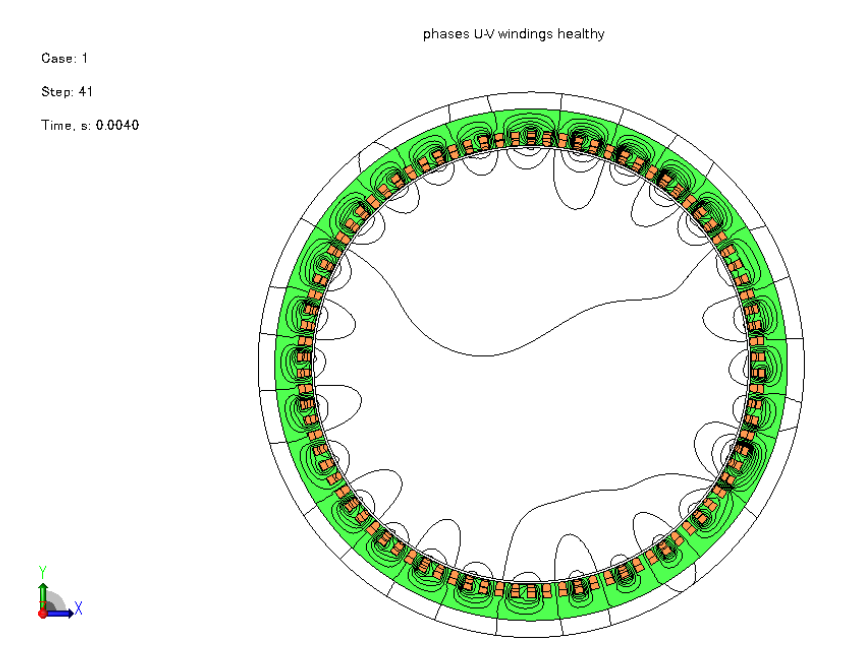How the axial flux of an induction motor can be used?
DOI:
https://doi.org/10.5604/01.3001.0013.2874Słowa kluczowe:
axial flux, rotor cage damage, inter-turn short circuits, load torque, rotational speed measurement, induction motor, testing station, contactless measurementsAbstrakt
The article contains the results of research within the project to apply unipolar (axial) flux to obtain diagnostic signals carrying the information of: electrical asymmetries of machinery (inter-turn stator short-circuits, cage damages); rotational speed of the rotor and load torque. Inter-turn stator short-circuits can be detected both at starting process time (when they appear most often), as well as in steady states. Detection of rotor cage defects in steady states has a character of a comparative study, and over time, as the defects develop. For standard drives that are powered from the network and work in open systems, by measuring the voltage following a unipolar flux, it is possible to make measurement and recording of motor speed, which usually is almost never provided under industrial conditions. The study shows that a simple in its construction, cheap coil can be a very useful diagnostic tool. The measurements were carried out at the laboratory and motor workplace in the power plant, while in the test station, during the loading, characteristics illustrating the dependence of the torque on the axial flux and on the rotational speed were obtained. A way of using a single measurement to estimate the torque has been proposed. The method is relatively simple to implement and allows for a fully non-invasive determination of the load torque.
Statystyka pobrań
Bibliografia
P. Ewert “Use of Axial Flux in the Detection of Electrical Faults in Induction Motors”, IEEE International Symposium on Electrical Machines (SME), 2017, 1–6. Google Scholar
D.G. Dorrell, W.T. Thomson, S. Roach “Analysis of airgap flux, current, and vibration signals as a function of the combination of static and dynamic air-gap eccentricity in 3-phase induction motors”, IEEE Transactions on Industry Applications, 1997, 33(1), 24–34. Google Scholar
V. Kokko “Condition monitoring of squirrel-cage motors by axial magnetic flux measurements”, Academic Dissertation, University of Oulu, 2003, Finland Google Scholar
L. Gołebiowski, M. Gołebiowski, M. Noga, J. Skwarczynski “Axial flow in 3D FEM model of induction machine”, Elektrotechnika i Elektronika, Vol. 25, No. 2, 147–152, 2006. Google Scholar
K. Chmelík, J. Foldyna, S. Mišák “Magnetické pole vokolí asynchronního stroje, jeho zjišťování a využití”, Electroscope, č. 2. Západočeská univerzita v Plzni, Fakulta elektrotechnická, 2007. Google Scholar
Bobon “3D Finite Element Computation of Axial Flux in Induction Motor”, Transactions on Electrical Engineering, vol. 1 (2012), No. 3 A247, 72–75. Google Scholar
W. Pietrowski “Wavelet analysis of axial flux in an induction machine on no-load test”, Electrical Review, Vol. 88, No. 7b/2012, 20–23, 2012. Google Scholar
W. Jarzyna “Diagnostic characteristics of Axial Flux in an Induction Motor”, Seventh International Conference on Electrical Machines and Drives, 1995 (Conf. Publ. No. 412), 141–146. Google Scholar
J. Tulicki, M. Sułowicz, J. Petryna “Application of the 2D field model to determine the axial flux signal for the purpose of diagnosing induction motors,” 2017 18th International Symposium on Electromagnetic Fields in Mechatronics, Electrical and Electronic Engineering (ISEF) Book of Abstracts, Lodz, 2017, pp. 1–2. Google Scholar
Petryna, J. Tulicki, M. Sułowicz “Calculating an electromechanical torque of a squirrel cage motor based on an axial flux obtained by the FEM”, II International Conference of Computational Methods in Engineering Science (CMES’17), 2017, ITM Web Conf., Volume 15, 1–8, 2017. Google Scholar
Frosini L., Borin A., Girometta, L., Venchi G.: Development of a leakage flux measurement system for condition monitoring of electrical drives. 2011 IEEE International Symposium on SDEMPED, 5–8 Sept. 2011, pp. 356–363. Google Scholar
Noga M., Petryna J.: Dynamic states in induction machines with internal asymmetries. TH Ilmenau Wiss. Zeitschr. 4/90. Google Scholar
Keysan O., Ertan H.B.: Higher Order Rotor Slot Harmonics for Rotor Speed & Position Estimation. 12th International Conference on Optimization of Electrical and Electronic Equipment, OPTIM 2010, pp. 416–421. Google Scholar
Tulicki, J. Petryna, M. Sułowicz “Fault diagnosis of induction motors in selected working conditions based on axial flux signals”, Technical Transactions, Issue: 13. Electrical Engineering, Issue: 3-E, 99–113, 2016. Google Scholar
Z. Ławrowski, A. Duda, J. Petryna, M. Sułowicz „Wyznaczanie momentu obciążenia silnika indukcyjnego w oparciu o pomiar strumienia poosiowego”, Zeszyty Problemowe – Maszyny Elektryczne, nr 110, 1–8, 2016. Google Scholar
M. Sułowicz, J. Tulicki, J. Petryna, A. Duda „Wpływ uszkodzeń silnika indukcyjnego na dokładność bezkontaktowego wyznaczania momentu elektromagnetycznego z sygnału strumienia poosiowego”, Zeszyty Problemowe – Maszyny Elektryczne, nr 119, 197–203, 2018. Google Scholar
J. Petryna, M. Sułowicz, A. Duda „Wykorzystanie strumienia poosiowego do badania stanów dynamicznych maszyn indukcyjnych małej i dużej mocy” Zeszyty Problemowe – Maszyny Elektryczne, Nr 2/2014 (102), str. 165–171. Google Scholar
J. Petryna, M. Sułowicz, Ł. Puzio, A.Dziechciarz „Wykrywanie zwarć zwojowych w maszynach elektrycznych na stacji prób z wykorzystaniem cewki do pomiaru strumienia poosiowego” Zeszyty Problemowe – Maszyny Elektryczne, Nr 2/2015 (106), str. 185–190. Google Scholar
J. Petryna, M. Sułowicz, A. Duda, K. Guziec „Wykorzystanie strumienia unipolarnego w diagnostyce maszyn prądu przemiennego” Zeszyty Problemowe – Maszyny Elektryczne, nr 2/2013(99), 85–90. Google Scholar
J. Petryna, M. Sułowicz, A. Duda, Z. Ławrowski, K. Guziec „Bezkontaktowe wyznaczanie momentu obciążenia silnika indukcyjnego na stanowisku pracy w energetyce w oparciu o pomiar strumienia poosiowego” Maszyny Elektryczne – Zeszyty Problemowe , Nr 2/2019 (122), 87–90. Google Scholar

Pobrania
Opublikowane
Jak cytować
Numer
Dział
Licencja
Prawa autorskie (c) 2019 Państwowa Wyższa Szkoła Zawodowa w Tarnowie & Autor

Utwór dostępny jest na licencji Creative Commons Uznanie autorstwa – Użycie niekomercyjne 4.0 Międzynarodowe.



